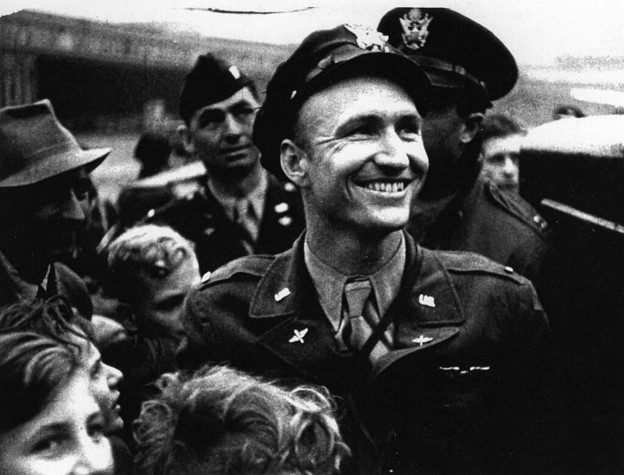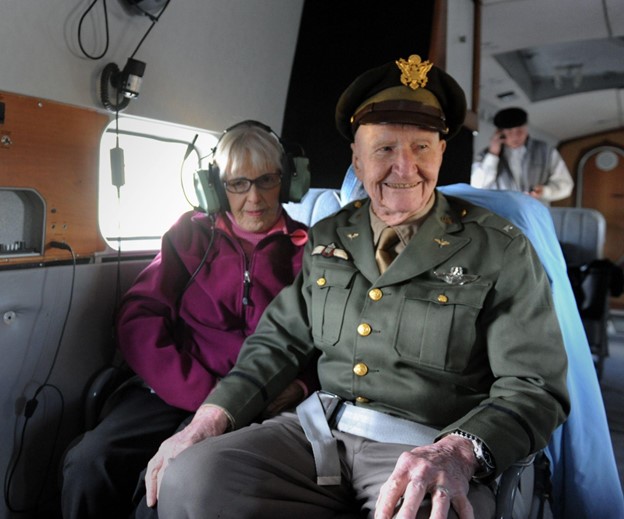Profiles In Courage: Gail Halvorson, the Berlin Airlift Candy Bomber

It didn't take long for East and West to clash after World War II. One of the first major crises of the new Cold War came in 1948 when the Soviet Union tried to cut Western-controlled West Berlin off from the rest of the world, starving its population and imposing its will on the only free city behind the Iron Curtain.
 The crisis might have escalated into a full-scale war had it not been for the determination to show the international community how the Free World handles business. The Allies decided to resupply West Berlin by air, leading to a 14-month airlift sending a plane to Berlin every 30 seconds.
The crisis might have escalated into a full-scale war had it not been for the determination to show the international community how the Free World handles business. The Allies decided to resupply West Berlin by air, leading to a 14-month airlift sending a plane to Berlin every 30 seconds.
The pilots of those planes carried fuel, food, and other necessary supplies for the city, some 3,475 tons every day. One of those pilots, Gail Halvorson, dropped gifts of his own: candies for the children of Berlin. Once the news got out that an American pilot was airdropping candy over Germany, other pilots joined in, the news spread worldwide, and Halvorson became known as "The Candy Bomber."
At the time, Berlin was very deep inside Soviet-occupied Germany. The Western allies had divided the country into zones of occupation, and the Red Army controlled a large chunk of the eastern side, including the capital. Berlin itself was also cut into four zones of control, putting American, French, and British zones in the same deep hole.
As the former World War II allies rebuilt Germany, they opted to do it in a way that mirrored their own countries, with the West becoming a capitalist state and the Soviet-dominated East falling to communism. When the West introduced a new currency, the Deutsche Mark, the USSR cut off railway, road, and canal access to Berlin in an effort to force the Allies to withdraw it. The Soviets believed resupply by a narrow air bridge was unfeasible.
 They were wrong, and the first battle of the new Cold War was a test of willpower. "Operation Vittles," as the Berlin Airlift was officially called, began on June 26, 1948. Pilots from Australia, Canada, South Africa, the U.S., Britain, and New Zealand took off from three airports in West Germany to deliver 2.34 million tons of vital supplies to the people of West Berlin, all day and every day for more than a year.
They were wrong, and the first battle of the new Cold War was a test of willpower. "Operation Vittles," as the Berlin Airlift was officially called, began on June 26, 1948. Pilots from Australia, Canada, South Africa, the U.S., Britain, and New Zealand took off from three airports in West Germany to deliver 2.34 million tons of vital supplies to the people of West Berlin, all day and every day for more than a year.
Halvorson was one of the regular pilots, and, despite the fame and love that his coming effort would create for him, he was originally against the whole idea. He later said he had "mixed feelings" about aiding their former enemy. Halvorson joined the Army Air Forces after the attack on Pearl Harbor, trained as a fighter pilot, and flew transport planes. During the war, he'd lost many friends to the Germans.
One day, he encountered a group of German children across the fences at the American airfield at Berlin's Tempelhof. He had two pieces of gum, which he split in half and handed to them. As he watched the children share the precious commodity, he promised to drop more the next day. As he did, he wiggled his wings.
Eventually, he started dropping candy, acquired through his own candy ration, on the city, using handkerchiefs as parachutes. When other Allied pilots and aircrews joined in, the Associated Press wrote a story about it, which led to an influx of candy and handkerchief donations from all over the Free World. They called their unofficial airdrops "Operation Little Vittles."
It wasn't until May 12, 1949, that the Soviets realized their strangulation plan wasn't going to make the Allies back down, and they lifted the blockade. Operation Little Vittles was as memorable to the people of Berlin as the airlift operation itself. Dubbed "The Candy Bomber" for the rest of his life, Halvorson was personally beloved in the German capital until he died in 2022 at age 101.